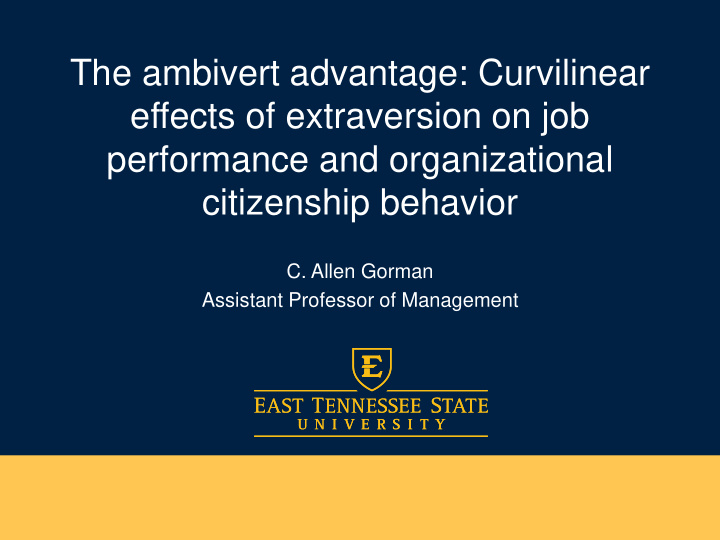



The ambivert advantage: Curvilinear effects of extraversion on job performance and organizational citizenship behavior C. Allen Gorman Assistant Professor of Management
The Extravert Ideal
The Extravert Ideal • Extraverts should have an advantage in customer service jobs – Extraverts tend to be outgoing, sociable, and comfortable initiating interactions with others (Furnham & Fudge, 2008) – Extraverts tend to express confidence and contagious levels of enthusiasm and energy (Vinchur, Schippmann, Switzer, & Roth, 1998)
The Extravert Ideal? • Jon Berghoff, Cutco sales rep • At age 19, he made a million dollars in commissions • Jon is a classic introvert, so how could he be successful at sales? – He easily adopts the role of advisor rather than persuader – He asks a lot of good questions – He listens closely to the answers
Reasons Extraverts May Not Be Ideal for Customer Service Jobs • Extraverts like to be the center of attention and quickly bounce from one conversation or idea to another (Judge, Piccolo, & Kosalka, 2009) • Extraverts tend to gravitate toward the spotlight (Ashton, Lee, & Paunonen, 2002) and they may inadvertently suppress or neglect others’ perspectives (Grant, Gino, & Hoffman, 2011) • Extraverts may elicit negative responses from customers because they may be perceived as overly excited and confident (Ames & Flynn, 2007; Judge et al., 2009)
Empirical Evidence? • The research evidence is mixed • Extraversion not significantly related to – performance in wholesale manufacturing sales (Barrick, Mount, & Strauss, 1993) – Health and fitness sales (Furnham & Fudge, 2008) – Business to business sales (Stewart, 1996) • In three meta-analyses, the average correlation between extraversion and sales performance was only .07 (Barrick, Mount, & Judge, 2001)
Problem One • Life is nonmonotonic (Grant & Schwartz, 2011) – The ubiquitous inverted-U (Suedfeld, 1969) – Too much of a good thing effect (Pierce & Aguinis, 2013) • Implications for personality, leadership, job design, personnel selection, positive psychology
Personality Example • Excessively high conscientiousness (Widiger, Trull, Clarkin, Sanderson, & Costa, 2002) – Stalled task completion – Overthinking – Preoccupation with order and detail
Problem Two • Mixed results of studies of curvilinear effects may be due to their reliance on dominance model response options (e.g., Likert-type scales, Strong Agree to Strongly Disagree ) – Dominance models assume the more of the attribute a person has, the higher the respondent’s endorsement rating will be
Extreme Conscientiousness Example • “I like to follow the rules” – Dominance model: predicts respondent would strongly agree – Ideal point model: predicts respondent may not fully endorse this item, not because they do not follow the rules, but because they always follow the rules whether they like it or not
Ideal Point Response Options • Do not assume monotonically increasing relationship • Individuals are more likely to endorse items that are located near their standing on the latent attribute continuum • Typical extreme Likert-type response options may not be appropriate for uncovering curvilinear relationships
Theoretically Appropriate Measurement Makes a Difference • Carter et al. (2014) found across 2 large samples of job incumbents that ideal point models uncovered curvilinear relationships between conscientiousness and job performance 100% of the time (versus 37.5% for classical test theory [i.e., Likert-type] models) • Personality tests with forced-choice scoring options (e.g., CPI,16PF) may be ideal (Stark, Chernyshenko, Drasgow, & Williams, 2006)
The Present Study • Research Question : Does extraversion (measured using a forced choice format) have a curvilinear relationship with job performance and organizational citizenship behavior for customer service employees?
Method • 129 customer service employees recruited from undergraduate psychology classes – Must work at least 20 hours per week – Mean age = 20.33 ( SD = 2.15) – 71% female – 71% Caucasian – Mean GPA = 3.48 ( SD = .59)
Measures • Hire-Intelligence Assessment Test (AT) – 186 items – 16 facets – Either 10 or 13 items per facet – Big 5 broad dimensions • Extraversion = Sociable + Bold + Outgoing • 36 items • Example: “When I meet people for the first time, I… a) don’t say much, b) in between, c) have no difficulty in thinking of something to say”
Measures • In-role performance ( Williams & Anderson, 1991 ) – 7 items – 1 ( strongly disagree ) to 7 ( strongly agree ) • Organizational citizenship behavior - Individual ( Williams & Anderson, 1991 ) – 7 items – 1 ( strongly disagree ) to 7 ( strongly agree )
Results • Completed supervisor ratings were returned for 86 of the 129 participants (67% completion rate) • Correlation between extraversion and – In-role performance: r = -.02, ns – OCB-I: r = .07, ns
Extraversion and Job Performance Scatterplot
Extraversion and OCB Scatterplot
Linear Effect of Extraversion on Job Performance
Linear Effect of Extraversion on OCB
Curvilinear Effect of Extraversion on Job Performance
Curvilinear Effect of Extraversion on OCB
Hierarchical Regression Analyses Predicting Job Performance and OCB Job Performance Step 1 ( R 2 = .001) Step 2 ( R 2 = .12**) Predictor β t (85) β t (84) Extraversion -.02 -.21 4.27 3.31** Extraversion 2 -4.31 -3.34** OCB Step 1 ( R 2 = .01) Step 2 ( R 2 = .05*) Predictor β t (85) β t (84) Extraversion .07 .62 2.71 1.99* Extraversion 2 -2.65 -1.95*
Conclusions • Extraversion may have a curvilinear relationship with job performance and OCBs of customer service employees • Researchers may be barking up the wrong tree looking for linear relationships • Researchers are likely using the wrong response options to uncover curvilinear relationships • Ambiverts may have an advantage when it comes to customer service jobs
Avenues for Future Research • Extreme extraversion may be related to CWBs • Ideal point scoring of AT • Additional field samples/job types • Other personality measures • Moderators?
Questions? • Thank you!
Recommend
More recommend